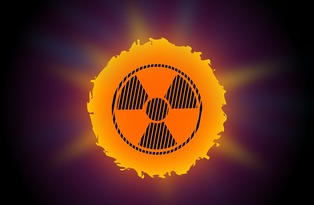
It wasn't until I got into my 30's and began to read and learn more about health that I started to become suspicious of the anti-sun propaganda that seemed to be cropping up everywhere.
How could the sun be so bad for us? The sun gives life and energy to just about everything on earth, so why were we all being told to avoid it at all costs? Are the sun's rays really "rays of death," as some media coverage would suggest, or is there something we are missing?
The truth, as with most truths when it comes to real health, is more complicated...
Is Sun Exposure Really "Deadly"?
Guest Post by Mike Geary, Author of The Fat Burning Kitchen & 101 Foods That Fight Aging
One thing that never made sense to me over the years was how the media and other sources have always tried to portray sun exposure as "the sun's deadly rays". It's as if they would have you believe that we need to live in caves and never see the sun to prevent cancer and stay in good health.But this is absurd if you think about it... the sun is THE provider of all life on earth. Without the sun, everything on earth would die.
Throughout the majority of human existence (with the exception of the last few decades), humans have always spent more time outdoors than indoors. Nowadays however, most of us are trapped inside offices all week long and might only get out into the sun once a week, if that.I've been doing a lot of reading and research over the last couple of years regarding sun exposure, cancer, vitamin D levels, etc. This subject of the sun and natural production of vitamin D can fill entire books, so I'll try to summarize my opinions and what I've learned in the past few years through a lot of my reading.
Don't worry, I'm not ignoring the fact that overexposure to the sun CAN cause problems, including cancer... but we need to also consider the fact that underexposure to the sun can have problems as well.
Let's look at a few points to consider:
1. Non-consistent sun exposure and infrequent SUNBURNS is the major cause of damage to the skin and increased risk of cancer... Think about your typical person that sits inside an office all week long without ever seeing the sun, and then gets FRIED at the pool or the beach on the weekend. THIS is where the damage occurs.
2. Regular consistent small amounts of exposure to the sun (without burning) can actually have a protective effect on the skin , increases healthful Vitamin D levels in the body, and can improve mood, help depression, and dozens of other benefits. Each individual's skin pigmentation determines what amount of sun exposure they can safely obtain without doing more harm than good.
For example, a very fair-skinned person with a far northern heritage might only be able to get 10-15 minutes of sun exposure over the majority of the body during peak hours before it does more harm than good. However, someone with darker skin and a heritage that originated closer to the equator might be able to get much longer periods of regular sun exposure without doing more harm than good.
3. Increasing Vitamin D levels from regular small doses of sunshine can actually decrease cancer risk. Vitamin D itself has been shown to have a protective effect through various processes in the body.
4. This one is interesting and deserves some thought -- According to Dr William Grant, a Vitamin D researcher, cancer rates in those living at high latitudes (farther north) such as Iceland are approximately 4 TIMES the cancer rates of those living at lower latitudes (closer to the equator) in the tropics.
Hmm, yet those people living in the tropics are getting MUCH higher levels of those so-called "deadly sun rays"... but they are also producing higher levels of protective Vitamin D on average too.
5. Vitamin D is actually produced into a hormone in our bodies and regulates hundreds of processes in the body, and is WAY MORE important to almost every single aspect of your health than most people realize. There is even evidence that due to the regulation of so many hormonal processes in our bodies that can be affected by Vitamin D, producing enough Vitamin D in your body can even help with fat loss, muscle building, blood sugar control, and hundreds of other factors.
6. It is hard to obtain enough Vitamin D from dietary sources alone (egg yolks, organ meats, and fatty fish are good sources, but still relatively small). The best utilized source of Vitamin D is what we produce in our bodies from moderate regular sun exposure over large portions of the body without burning. It's vitally important to note that the UVB rays are only strong enough to trigger vitamin D production in your body mid day if the sun is at least approx 30 degrees above the horizon in terms of height in the sky or higher . Of course, this is the exact time that well-meaning, but uneducated "health experts" erroneously tell you to stay out of the sun.
UVB rays aren't strong enough in the early morning or late afternoon to trigger vitamin D production, so you must get moderate exposure over large portions of your body for small amounts of time (10-30 minutes depending on skin pigmentation) in the middle of the day to reap the benefit of Vitamin D production. I explain in more detail in this article about your ability to produce vitamin D at different times of the year and times of day based on your latitude.
7. An antioxidant-rich diet can help to protect the skin (to an extent) from damage if you get too much sun exposure. This means that getting lots of antioxidants from things such as various teas (green, black, white, rooibos, yerba mate, chammomile, etc), various berries, fruits, vegetables, beta carotene, nuts, olive oil, coffee, etc, etc can help to protect your skin.
8. Another point that proves that irregular burning is the major cause of damage and not regular small doses of sunshine... Rates of skin cancer are typically higher in areas of the body that get irregular sun and occasional burning as opposed to areas of the body that have received consistent sun for your entire life.
Notice how more cancer is often found on the back and chest (places that get irregular sun and more burning) vs the back of the neck or the forearms (which get consistent regular sun for most people our entire lives). There are exceptions to everything, but this seems to be a common trend.
9. I've come across studies over the last few years that indicated skin caner rates are higher among indoor office workers compared to outdoor workers. This is yet another interesting trend... it basically supports the conclusion that being underexposed to sunlight most of the time (working inside an office all week long) and then getting infrequent overexposure to the sun is a lot more problematic compared to an outdoor worker that gets regular daily sun exposure.
Of course, the indoor worker can always avoid this problem by getting outside for 10-20 minutes daily during breaks to get those protective small daily doses of sunshine that we've been talking about here.
10. Think about this issue in terms of common sense -- Don't you feel a heck of a lot better and more energetic when you've at least gotten out in the sun for 20 or 30 minutes in a day rather than being stuck inside all day?
So what's the best way to do this in a healthy way while minimizing sun overexposure risk?
a. In the winter in northern latitudes (above approx South Carolina latitudes in the US), your vitamin D levels may fall to dangerously low levels if you go for several months without getting any sun. In winter, since your body will not be producing enough Vitamin D from the sun, you need to make sure to increase your intake in your diet... as I mentioned, fatty fish, egg yolks, and organ meats are some of the best dietary sources of vitamin D, but still generally don't increase your body's vitamin D levels that much.
I like to take a small amount of daily cod liver oil in the deepest months of winter to make sure my Vitamin D levels don't go too low. You also need to be careful not to take too much cod liver oil though as some scientists believe that excessive amounts of cod liver oil can give you overdoses of vitamin A.
b. In the spring, try to start with just small periods in the sun such as 10-15 minutes/day over large portions of your body (not just your hands and face). The more skin surface exposed to the sun, the more vitamin D that your body will produce. Make sure to try to NEVER get a sunburn! Gradual small doses of sunshine over a large part of your body almost daily helps your body produce the most beneficial and protective Vitamin D levels.
c. Avoid extended periods of overexposure to the sun on large portions of your body... If you're going to be out for several hours or an entire day in the sun, you'll still need to make sure to cover up appropriately (based on your individual skin pigmentation and sensitivity) to prevent burning and skin damage... remember that we're talking about regular small doses of sunshine that is beneficial, not entire days out in the sun without covering up.
Warning about sunscreens:
I would caution against relying heavily on chemical-based sunscreens as most of the chemicals used in sunscreens are potentially carcinogenic and are also known to be estrogenic, as they absorb through your skin and into your body. If you're going to use a lotion based sunblock, you're best bet is a natural form that uses zinc oxide or titanium dioxide ... These are natural sunblocks that don't absorb into your skin, but rather sit on top of the skin's surface and block the rays. This is a big difference compared to the harmful chemicals that are in most sunscreens and can absorb through your skin (various benzones, homosalate, etc). Choose sunscreens that are on the EWG Safe Sunscreens list if you must use a sunscreen.
d. Load up on antioxidant-rich foods such as various teas, organic coffee, fruits and veggies, berries, etc daily to help prevent free radical damage and protect your skin.
e. Lastly, I'm not a doctor, so many of the points in this article are my opinions based on years of reading and research. Make sure to consult with your doctor on your individual health characteristics and how this relates to sun exposure and vitamin D.
About the Author
---------------------------------------------------
Mike Geary is a Certified Nutrition Specialist, Certified Personal Trainer, and author of a number of bestselling books including The Fat Burning Kitchen, and The Top 101 Foods that Fight Aging. He also owns several health blogs and websites about natural health and fitness. You can learn more about Mike here.



 RSS Feed
RSS Feed